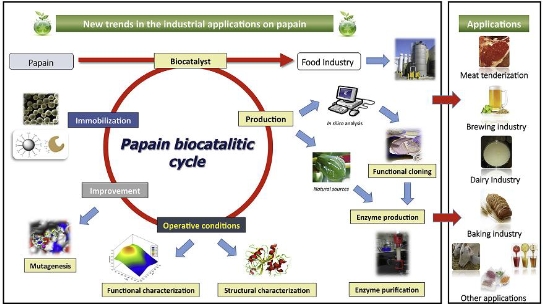Review on “scope and opportunities of papain as food tenderizing agent for food processing in Ethiopia”
DOI:
https://doi.org/10.18686/fnc.v1i2.51Keywords:
bio-catalysis; cysteine proteases; enzyme biotechnology; immobilization; industrial processes papainAbstract
The basic goal of food preservation is to limit microbial development during storage, which promotes a longer shelf life and lowers the risk of food poisoning. Fruits and vegetables are a crucial addition to the human diet because they include the essential vitamins, minerals, and fiber needed to sustain good health. Papaya contains a proteolytic enzyme known as papain, which is used in a variety of food processing procedures to break down proteins. The objective of this review is to carefully study the extraction methods for the papain enzyme that employ grinding and ultra-sonication extraction techniques and determine the application of papain as a preservative in future studies. Because the papaya fruit contains cysteine proteinases, it can be used as a significant instrument in pharmacology and medicine. The papaya fruit and seeds all contain carpaine, an alkaloid with a bitter taste that has a potent heart-depressant effect. Food preservation primarily aims to maintain the nutritional value of food, while also preserving its appearance and increasing its shelf life. Due to papaya’s widespread popularity and reputation for its high nutritional value, it is necessary to fortify the fruit with the best preservation enzyme. Enzymes have evolved into critical tools for numerous industries, most notably food, animal feed, biofuel, detergent, textile, pulp, and paper industries.

Downloads
Published
How to Cite
Issue
Section
License
Copyright (c) 2023 Birhanu Zeleke Tilinti

This work is licensed under a Creative Commons Attribution-NonCommercial 4.0 International License.
References
1. Chandrasekaran M. Enzymes in Food and Beverage Processing, 1st ed. CRC Press; 2016.
2. Ayele L, Etissa E, Dagnew A, et al. Development of hermaphrodite papaya (Carica papaya L.) varieties for production in Ethiopia. Academic Research Journal of Agricultural Science and Research 2017; 5(7): 561–569.
3. Hailemariam T, Aregahegn A, Bekele T, Madhusudhan A. Investigation of the levels of selected metals in edible and medicinal fruits grown in Dilla, Ethiopia. Research Journal of Chemical and Environmental Sciences 2015; 3(4): 44–53.
4. Yogiraj V, Goyal PK, Chauhan CS, et al. Carica papaya Linn: An overview. International Journal of Herbal Medicine 2014; 2(5): 1–8.
5. Varmudy V. Papaya: Waiting for a planned commercial strategy. Facts For You, May 2011, pp. 16–18.
6. Tigist M, Getnet B, Beza K, et al. Extraction and purification of papain enzyme from papaya leaf and the phytochemical components of the leaf. Tigist et al Biotechnology International 2016; 9(8): 176–184.
7. Lambri M, Roda A, Dordoni R, et al. Mild process for dehydrated food-grade crude papain powder from papaya fresh pulp: Lab-scale and pilot plant experiments. Chemical Engineering Transactions 2014; 38: 7–12. doi: 10.3303/CET1438002
8. Pathak PD, Mandavgane SA, Kulkarni BD. Waste to wealth: A case study of papaya peel. Waste and Biomass Valorization 2019; 10: 1755–1766. doi: 10.1007/s12649-017-0181-x
9. Paul B, Nasreen M, Sarker A, Islam MR. Isolation, purification and modification of papain enzyme to Ascertain industrially valuable nature. International Journal of Bio-Technology and Research (IJBTR) 2013; 3(5): 11–22.
10. Akpan IP, Omojola AB. Quality attributes of crude papain injected beef. Journal of Meat Science and Technology 2015; 3(4): 42–46.
11. Malek K, Norazan M, Parasuraman R, et al. Production of cysteine proteases by recombinant microorganisms: A critical review. IOSR Journal of Pharmacy and Biological Sciences 2016; 11(2): 35–40. doi: 10.9790/3008-1102043540
12. Msagati TAM. The Chemistry of Food Additives and Preservatives. Wiley-Blackwell; 2013.
13. Margean A, Mazarel A, Lupu MI, Canja CM. Tenderization, a method to optimize the meat sensory quality. Bulletin of the Transilvania University of Brasov. Series II: Forestry, Wood Industry, Agricultural Food Engineering 2017; 10(1): 125–130.
14. Yoo YJ, Feng Y, Kim YK, Yagonia CFJ. Fundamentals of Enzyme Engineering. Springer; 2017.
15. Fernández-Lucas J, Castañeda D, Hormigo D. New trends for a classical enzyme: Papain, a biotechnological success story in the food industry. Trends in Food Science& Technology 2017; 68: 91–101. doi: 10.1016/j.tifs.2017.08.017
16. Adiaha MS. Effect of nutritional, medicinal and pharmacological properties of papaya (Carica papaya Linn.) to human development: A review. World Scientific News 2017; 67(2): 238–249.
17. Zhang Y, He S, Simoson BK. Enzymes in food bioprocessing—Novel food enzymes, applications, and related techniques. Current Opinion in Food Science 2018; 19: 30–35. doi: 10.1016/j.cofs.2017.12.007
18. Patel AK, Singhania RR Pandey A. Novel enzymatic processes applied to the food industry. Current Opinion in Food Science 2016; 7: 64–72. doi: 10.1016/j.cofs.2015.12.002
19. Branen AL, Davidson PM, Salminen S, Sarngote JH. Food Additives. Marcel Dekker, Inc.; 2002.
20. Kang CK, Warner WD. Tenderization of meat with latex proteases. Journal of Food Science 2007; 39(4): 812–818. doi: 10.1111/j.1365-2621.1974.tb17985.x
21. Steen RWJ. The effect of additive treatment of grass silage and the food additive avoparcin on the response of calves to supplementation of silage-based diets with fish meal. Animal Sciences 2010; 47(2): 245–252. doi: 10.1017/S0003356100003329
22. Maiti AK, Ahlawat SS, Sharma DP, Khanna N. Application of natural tenderizers in meat—A review. Agricultural Review 2008; 29(3): 226–230.
23. Patel AK, Singhania RR, Pandey A. Novel enzymatic processes applied to the food industry. Current Opinion in Food Science 2016; 7: 64–72. doi: 10.1016/j.cofs.2015.12.002
24. Isa MBM. Extraction of Papain Enzymes from Papaya Leaves [Bachelor’s thesis]. Universiti Malaysia Pahang; 2010.
25. Rico D, Martin-Diana AB, Barat JM, Barry-Ryan C. Extending and measuring the quality of fresh-cut fruit and vegetables: A review. Trends in Food Science & Technology 2007; 18(7): 373–386. doi: 10.1016/j.tifs.2007.03.011




.jpg)
.jpg)

